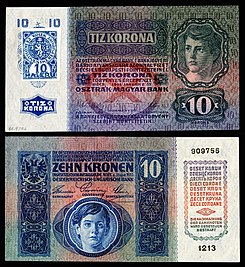| československá koruna (Czech and Slovak) | |
|---|---|
 One Crown of the First Czechoslovak Republic | |
| ISO 4217 | |
| Code | CSK |
| Unit | |
| Plural | The language(s) of this currency belong(s) to the Slavic languages. There is more than one way to construct plural forms. |
| Symbol | Kčs |
| Denominations | |
| Subunit | |
| 1⁄100 | haléř (Czech) halier (Slovak) |
| Banknotes | |
| Freq. used | 10, 20, 50, 100 Kčs |
| Rarely used | 500, 1000 Kčs |
| Coins | |
| Freq. used | 10, 20, 50 h; 1, 2, 5 Kčs |
| Rarely used | 5 h, 3, 10 Kčs |
| Demographics | |
| User(s) |
|
| Issuance | |
| Central bank | State Bank of Czechoslovakia |
| Printer | Státní tiskárna cenin (State Securities Printer, Prague) |
| Website | www |
| Mint | Mincovňa Kremnica (Kremnica Mint) |
| Website | www |
| Valuation | |
| Inflation | 57.9% |
| Source | World Bank, 1991[1] |
| This infobox shows the latest status before this currency was rendered obsolete. | |
The Czechoslovak koruna (in Czech and Slovak: koruna československá, at times koruna česko-slovenská; koruna means crown) was the currency of Czechoslovakia from 10 April 1919 to 14 March 1939, and from 1 November 1945 to 7 February 1993. For a brief time in 1939 and again in 1993, it was also the currency of both the separate Czech Republic and Slovakia.
On 8 February 1993, it was replaced by the Czech koruna and the Slovak koruna, both at par.
The (last) ISO 4217 code and the local abbreviations for the koruna were CSK and Kčs. One koruna equalled 100 haléřů (Czech, singular: haléř) or halierov (Slovak, singular: halier). In both languages, the abbreviation h was used. The abbreviation was placed behind the numeric value.
